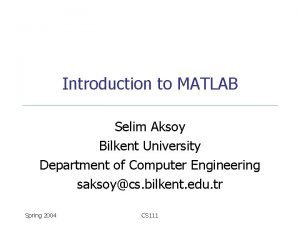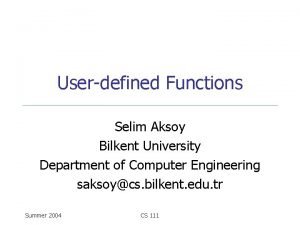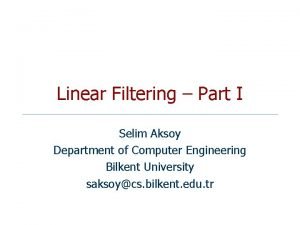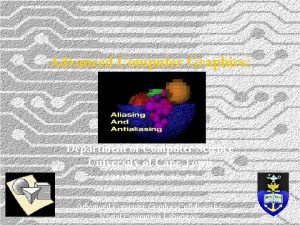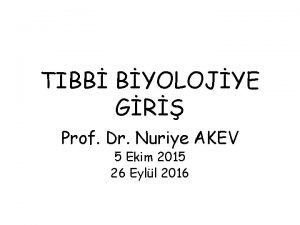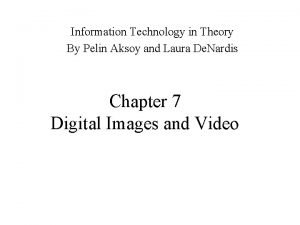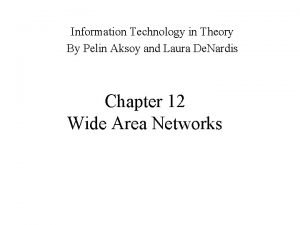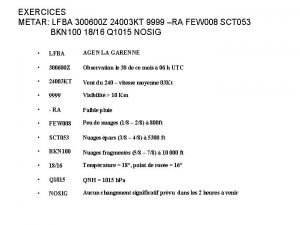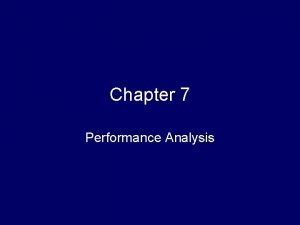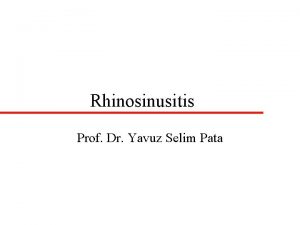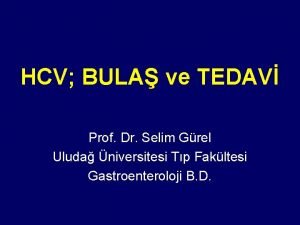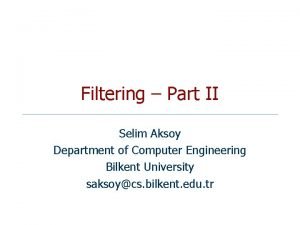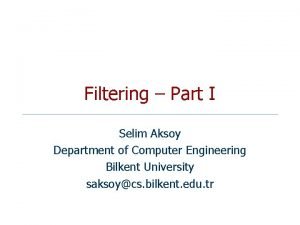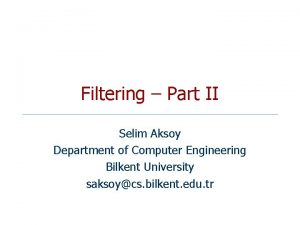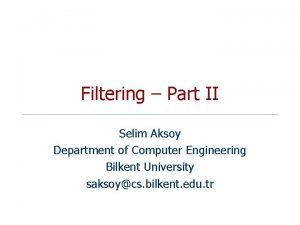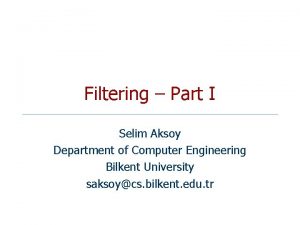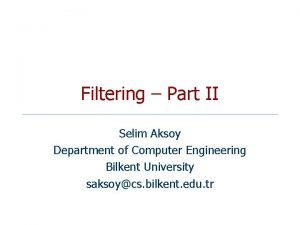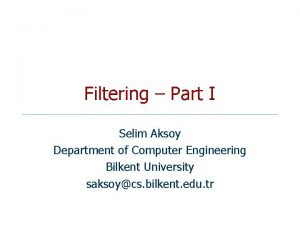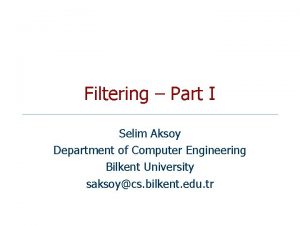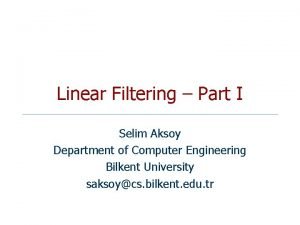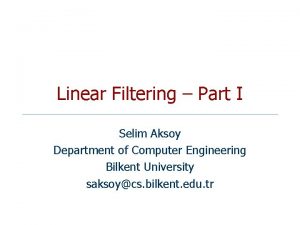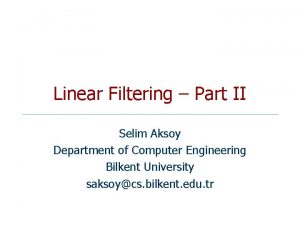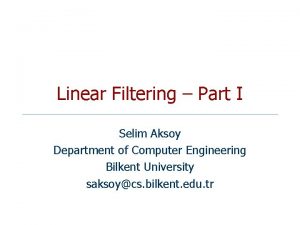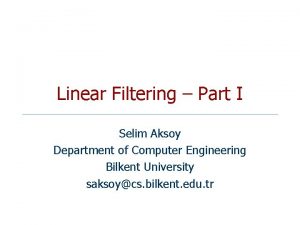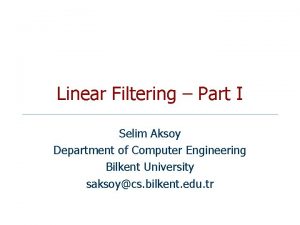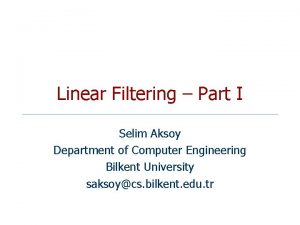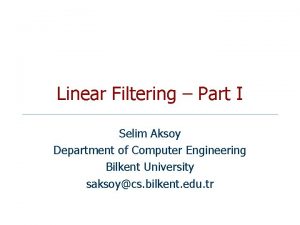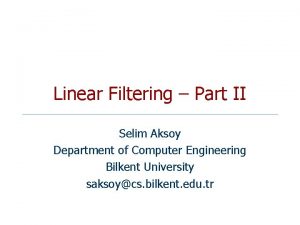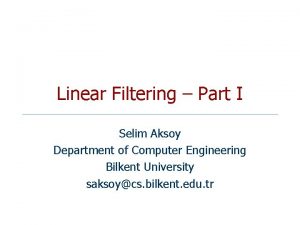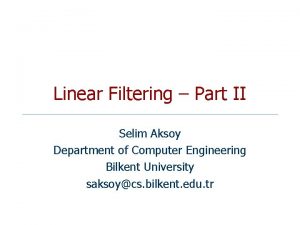Filtering Part II Selim Aksoy Department of Computer






























- Slides: 30

Filtering – Part II Selim Aksoy Department of Computer Engineering Bilkent University saksoy@cs. bilkent. edu. tr

Fourier theory n n The Fourier theory shows how most real functions can be represented in terms of a basis of sinusoids. The building block: n n A sin( ωx + Φ ) Add enough of them to get any signal you want. Adapted from Alexei Efros, CMU CS 484, Fall 2019 © 2019, Selim Aksoy 2

Fourier transform CS 484, Fall 2019 © 2019, Selim Aksoy 3

Fourier transform CS 484, Fall 2019 © 2019, Selim Aksoy 4

Fourier transform CS 484, Fall 2019 © 2019, Selim Aksoy 5

Fourier transform CS 484, Fall 2019 © 2019, Selim Aksoy 6

Fourier transform CS 484, Fall 2019 © 2019, Selim Aksoy 7

Fourier transform CS 484, Fall 2019 © 2019, Selim Aksoy 8

Fourier transform - matlab A=1; K=10; M=100 ; t=[ones(1, K)*A zeros(1, M-K ; [( subplot(3, 1, 1); bar(t); ylim([0 2*A([ subplot(3, 1, 2); bar(abs(fftshift(fft(t)))); ylim([0 A*K+1]) % Matlab uses DFT formulation without normalization by M. subplot(3, 1, 3); bar(real(fftshift(fft(t)))); ylim([-A*K+1]) CS 484, Fall 2019 © 2019, Selim Aksoy Adapted from Gonzales and Woods 9

Fourier transform To get some sense of what basis elements look like, we plot a basis element --- or rather, its real part --as a function of x, y for some fixed u, v. We get a function that is constant when (ux+vy) is constant. The magnitude of the vector (u, v) gives a frequency, and its direction gives an orientation. The function is a sinusoid with this frequency along the direction, and constant perpendicular to the direction. v u Adapted from Antonio Torralba CS 484, Fall 2019 © 2019, Selim Aksoy 10

Fourier transform Here u and v are larger than in the previous slide. v u Adapted from Antonio Torralba CS 484, Fall 2019 © 2019, Selim Aksoy 11

Fourier transform And larger still. . . v u Adapted from Antonio Torralba CS 484, Fall 2019 © 2019, Selim Aksoy 12

Fourier transform How to interpret a Fourier spectrum: Vertical orientation Low spatial frequencies 45 deg. 0 Horizontal orientation 0 fmax fx in cycles/image High spatial frequencies Log power spectrum Adapted from Antonio Torralba CS 484, Fall 2019 © 2019, Selim Aksoy 13

Fourier transform A 1 B 2 C 3 Adapted from Antonio Torralba CS 484, Fall 2019 © 2019, Selim Aksoy 14

Fourier transform CS 484, Fall 2019 © 2019, Selim Aksoy Adapted from Shapiro and Stockman 15

Convolution theorem CS 484, Fall 2019 © 2019, Selim Aksoy 16

Frequency domain filtering CS 484, Fall 2019 © 2019, Selim Aksoy Adapted from Shapiro and Stockman, and Gonzales and Woods 17

Frequency domain filtering CS 484, Fall 2019 © 2019, Selim Aksoy 18

Frequency domain filtering f(x, y) |F(u, v)| h(x, y) |H(u, v)| g(x, y) |G(u, v)| CS 484, Fall 2019 © 2019, Selim Aksoy Adapted from Alexei Efros, CMU 19

Template matching n n Correlation can also be used for matching. If we want to determine whether an image f contains a particular object, we let h be that object (also called a template) and compute the correlation between f and h. If there is a match, the correlation will be maximum at the location where h finds a correspondence in f. Preprocessing such as scaling and alignment is necessary in most practical applications. CS 484, Fall 2019 © 2019, Selim Aksoy 20

Template matching Face detection using template matching: detected faces. CS 484, Fall 2019 © 2019, Selim Aksoy 21

Resizing images How can we generate a half-sized version of a large image? CS 484, Fall 2019 © 2019, Selim Aksoy Adapted from Steve Seitz, U of Washington 22

Resizing images 1/8 1/4 Throw away every other row and column to create a 1/2 size image (also called sub-sampling). CS 484, Fall 2019 © 2019, Selim Aksoy Adapted from Steve Seitz, U of Washington 23

Resizing images 1/2 CS 484, Fall 2019 1/4 (2 x zoom) 1/8 (4 x zoom) Does this look nice? Adapted from Steve Seitz, U of Washington © 2019, Selim Aksoy 24

Resizing images n n We cannot shrink an image by simply taking every k’th pixel. Solution: smooth the image, then sub-sample. Gaussian 1/8 Gaussian 1/4 Gaussian 1/2 CS 484, Fall 2019 © 2019, Selim Aksoy Adapted from Steve Seitz, U of Washington 25

Resizing images Gaussian 1/2 CS 484, Fall 2019 Gaussian 1/4 (2 x zoom) © 2019, Selim Aksoy Gaussian 1/8 (4 x zoom) Adapted from Steve Seitz, U of Washington 26

Sampling and aliasing n n Errors appear if we do not sample properly. Common phenomenon: n n High spatial frequency components of the image appear as low spatial frequency components. Examples: n n n Wagon wheels rolling the wrong way in movies. Checkerboards misrepresented in ray tracing. Striped shirts look funny on color television. CS 484, Fall 2019 © 2019, Selim Aksoy 27

Sampling and aliasing CS 484, Fall 2019 © 2019, Selim Aksoy Adapted from Ali Farhadi 28

Gaussian pyramids CS 484, Fall 2019 © 2019, Selim Aksoy Adapted from Gonzales and Woods 29

Gaussian pyramids CS 484, Fall 2019 © 2019, Selim Aksoy Adapted from Michael Black, Brown University 30
 Selim aksoy bilkent
Selim aksoy bilkent Bilkent matlab
Bilkent matlab Selim aksoy bilkent
Selim aksoy bilkent Too many input arguments.
Too many input arguments. Selim aksoy
Selim aksoy Selim aksoy bilkent
Selim aksoy bilkent Selim aksoy bilkent
Selim aksoy bilkent Linear filtering
Linear filtering Ingress filtering vs egress filtering
Ingress filtering vs egress filtering Post filtering in computer graphics
Post filtering in computer graphics Weighted area sampling
Weighted area sampling Hayvan hücresi ve bitki hücresi
Hayvan hücresi ve bitki hücresi Metar aksoy
Metar aksoy Shihomi ara aksoy
Shihomi ara aksoy Remzi can aksoy
Remzi can aksoy Pelin aksoy
Pelin aksoy Metar lirf
Metar lirf Yunus aksoy
Yunus aksoy Metar aksoy
Metar aksoy Mosque of selim ii floor plan
Mosque of selim ii floor plan Selim akl
Selim akl Yavuz selim pata
Yavuz selim pata Selim opilec
Selim opilec Yavuz sultan selim mosque
Yavuz sultan selim mosque Prof dr selim gürel
Prof dr selim gürel Magdy selim
Magdy selim Ucl computer science faculty
Ucl computer science faculty Northwestern university computer engineering
Northwestern university computer engineering Computer science department rutgers
Computer science department rutgers Meredith hutchin stanford
Meredith hutchin stanford Fsu cs faculty
Fsu cs faculty

